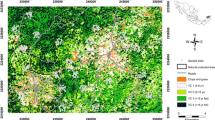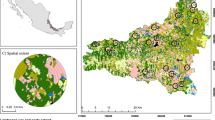Abstract
The aim of this work is to examine whether there exists a link between local and landscape patterns of species commonness, and if these are related to morphological traits in tropical plant communities. The Madidi region (Bolivian tropical Andes) is selected as study location. We estimated local and landscape commonness, rarity classes, height, diameter, number of stems, and habit for >2,300 species. We employed correlations to evaluate the relationship between local scale commonness and landscape scale commonness. We performed ANCOVA and multinomial logistic regressions to predict commonness and rarity variables from the morphological traits. We repeated the analyses for six different forest types, including dry forests and wet forests along a 3,477 m elevation gradient. We found a positive relationship between local and landscape commonness in all forest types. Additionally, we found that, plant height influences the local and landscape commonness, and that the apportioning of species into rarity classes depends greatly on the species habit and, at lesser degree, on the number of stems. Our main conclusions are: (1) Approaches to commonness and rarity based on abundance only or occurrence only could summarize most of the relevant information to characterize commonness and rarity patterns: both approaches, in practice, do not supply independent information. (2) The species traits determine which species are rare and which ones are common, which indicates that commonness and rarity patterns are the result of non-neutral trait-based community assembly processes.


Similar content being viewed by others
References
Aarssen LW, Schamp BS, Pither J (2006) Why are there so many small plants? Implications for species coexistence. J Ecol 94:569–580
Arellano G, Cayola L, Loza I et al (2014) Commonness patterns and the size of the species pool along a tropical elevational gradient: insights using a new quantitative tool. Ecography 37:536–543
Bazzaz FA (1975) Plant species diversity in old-field successional ecosystems in Southern Illinois. Ecology 56:485–488
Bellingham PJ, Sparrow AD (2000) Resprouting as a life history strategy in woody plant communities. Oikos 89:409–416
Bellingham PJ, Sparrow AD (2009) Multi-stemmed trees in montane rain forests: their frequency and demography in relation to elevation, soil nutrients and disturbance. J Ecol 97:472–483
Brown JH (1984) On the relationship between abundance and distribution of species. Am Nat 124:255–279
Clarck PJ, Evans FC (1954) Distance to nearest neighbor as a measure of spatial relationships in populations. Ecology 35:445–453
Connell JH (1971) On the role of natural enemies in preventing competitive exclusion in some marine animals and in rain forest trees. In: Boer P, Gradwell G (eds) Dynamics of populations. Centre for Agricultural Publications and Documentation, Wageningen
Davidar P, Rajagopal B, Arjunan M, Puyravaud JP (2008) The relationship between local abundance and distribution of rain forest trees across environmental gradients in India. Biotropica 40:700–706
Fuentes A (2005) Una introducción a la vegetación de la región de Madidi. Ecología en Bolivia 40:1–31
Gaston KJ (1994) Rarity. Chapman & Hall, London
Gaston KJ (2010) Valuing common species. Science 327:154–155
Gaston KJ (2012) The importance of being rare. Nature 487:46–47
Gaston KJ, Blackburn TM, Greenwood JJD et al (2000) Abundance-occupancy relationships. J Appl Ecol 37:39–59
Gentry AH (1991) The distribution and evolution of climbing plants. In: Putz FE, Mooney HA (eds) The biology of vines. Cambridge University Press, Cambridge
Hanski I (1982) Dynamics of regional distribution: the core and satellite species hypothesis. Oikos 38:210–221
Hui C, McGeoch MA, Reyers B et al (2009) Extrapolating population size from the occupancy-abundance relationship and the scaling pattern of occupancy. Ecol Appl 19:2038–2048
Hui C, Veldtman R, McGeoch MA (2010) Measures, perceptions and scaling patterns of aggregated species distributions. Ecography 33:95–102
Huston M (1979) A general hypotheses of species diversity. Am Nat 113:81–101
Itoh A, Yamakura T, Ogino K et al (1997) Spatial distribution patterns of two predominant emergent trees in a tropical rainforest in Sarawak, Malaysia. Plant Ecol 132:121–136
Janzen DH (1970) Herbivores and the number of tree species in tropical forests. Am Nat 104:501–528
Jiménez-Castillo M, Wiser SK, Lusk CH (2006) Elevational parallels of latitudinal variation in the proportion of lianas in woody floras. J Biogeogr 34:163–168
Kelly C, Woodward F, Crawley M (1996) Ecological correlates of plant range size: taxonomies and phylogenies in the study of plant commonness and rarity in Great Britain. Philos Trans Biol Sci 351:1261–1269
Kristiansen T, Svenning J-C, Grández C et al (2009) Commonness of Amazonian palm (Arecaceae) species: cross-scale links and potential determinants. Acta Oecol 35:554–562
Letcher SG, Chazdon RL (2012) Life history traits of lianas during tropical forest succession. Biotropica 44(6):720–727
Macía MJ, Svenning J-C (2005) Oligarchic dominance in western Amazonian plant communities. J Trop Ecol 21:613–626
McGill BJ, Enquist BJ, Weiher E, Westoby M (2006a) Rebuilding community ecology from functional traits. Trends Ecol Evol 21:178–185
McGill BJ, Maurer BA, Weiser MD (2006b) Empirical evaluation of neutral theory. Ecology 87:1411–1423
McGill BJ, Etienne RS, Gray JS et al (2007) Species abundance distributions: moving beyond single prediction theories to integration within an ecological framework. Ecol Lett 10:995–1015
Moles AT, Westoby M (2004) Seedling survival and seed size: a synthesis of the literature. J Ecol 92:372–383
Moles AT, Falster DS, Leishman MR, Westoby M (2004) Small-seeded species produce more seeds per square metre of canopy per year, but not per individual per life-time. J Ecol 92:384–396
Nathan R, Muller-Landau H (2000) Spatial patterns of seed dispersal, their determinants and consequences for recruitment. Trends Ecol Evol 15:278–285
Navarro G, Ferreira W, Antezana C et al (2004) Bio-corredor Amboró Madidi, zonificación ecológica. Editorial FAN, Santa Cruz
Pérez-Salicrup DR, Schnitzer S, Putz FE (2004) Community ecology and management of lianas. For Ecol Manage 190:1–2
Pitman NCA, Terborgh J, Silman MR, Núñez P (1999) Tree species distributions in an upper Amazonian forest. Ecology 80:2651–2661
Pitman NCA, Terborgh JW, Silman MR et al (2001) Dominance and distribution of tree species in upper Amazonian terra firme forests. Ecology 82:2101–2117
Pitman NCA, Silman MR, Terborgh JW (2013) Oligarchies in Amazonian tree communities: a ten-year review. Ecography 36:114–123
Preston FW (1948) The commonnes, and rarity, of species. Ecology 29:254–283
Rabinowitz D (1981) Seven forms of rarity. In: Synge H (ed) The biological aspects of rare plant conservation. Wiley, New York
Rabinowitz D, Cairns S, Dillon T (1986) Seven forms of rarity and their frequency in the flora of the British Isles. In: Soulé ME (ed) Conservation biology: the science of scarcity and diversity. Sinauer Associates Inc, Sunderland
Ricklefs RE (2000) Rarity and diversity in Amazonian forest trees. Trends Ecol Evol 15:83–84
Romero-Saltos H, Valencia R, Macia MJ (2001) Patrones de diversidad, distribucion y rareza de plantas leñosas en tres tipos de bosque en la Amazonia nororiental ecuatoriana. Evaluación de recursos forestales no maderables en la Amazonía noroccidental. IBED-Universiteit van Amsterdam, Amsterdam
Ruokolainen K, Vormisto J (2000) The most widespread Amazonian palms tend to be tall and habitat generalists. Basic Appl Ecol 1:97–108
Schawe M, Glatzel S, Gerold G (2007) Soil development along an altitudinal transect in a Bolivian tropical montane rainforest: podzolization versus hydromorphy. Catena 69:83–90
Schnitzer SA (2005) A mechanistic explanation for global patterns of liana abundance and distribution. Am Nat 166:262–276
Schnitzer SA, Bongers F (2002) The ecology of lianas and their role in forests. Trends Ecol Evol 17:223–230
ter Steege H, Pitman NCA, Sabatier D et al (2013) Hyperdominance in the Amazonian tree flora. Science 342. doi:10.1126/science.124309
Violle C, Enquist BJ, McGill BJ et al (2012) The return of the variance: intraspecific variability in community ecology. Trends Ecol Evol 27:244–252
Vormisto J, Svenning J-CC, Hall P, Balslev H (2004) Diversity and dominance in palm (Arecaceae) communities in terra firme forests in the western Amazon basin. J Ecol 92:577–588
Westoby M, Falster DS, Moles AT et al (2002) Plant ecological strategies: some leading dimensions of variation between species. Annu Rev Ecol Syst 33:125–159
Wright IJ, Ackerly DD, Bongers F et al (2007) Relationships among ecologically important dimensions of plant trait variation in seven neotropical forests. Ann Bot 99:1003–1015
Acknowledgments
We are very grateful to P. M. Jørgensen, coordinator of the Madidi Project, and to L. E. Cayola, A. F. Fuentes, A. Araújo-Murakami, M. Cornejo, V. W. Torrez, J. M. Quisbert, T. B. Miranda, R. Seidel, N. Y. Paniagua, and C. Maldonado, who provided very valuable plot data for the present study. We also appreciate the indispensable help of many students and volunteers who collaborated in the field and herbarium. We thank the Dirección General de Biodiversidad, the ServicioNacional de ÁreasProtegidas, Madidi National Park, and local communities for permits, access, and collaboration during the fieldwork. An anonymous reviewer provided useful comments to the manuscript. We received financial support from the following institutions: Consejería de Educación (Comunidad de Madrid), National Geographic Society (8047-06, 7754-04), US National Science Foundation (DEB#0101775, DEB#0743457), and Universidad Autónoma de Madrid—Banco Santander, for which we are grateful.
Author information
Authors and Affiliations
Corresponding author
Additional information
Communicated by Peter Ashton.
Rights and permissions
About this article
Cite this article
Arellano, G., Loza, M.I., Tello, J.S. et al. Commonness and rarity determinants of woody plants in different types of tropical forests. Biodivers Conserv 24, 1073–1087 (2015). https://doi.org/10.1007/s10531-014-0843-y
Received:
Revised:
Accepted:
Published:
Issue Date:
DOI: https://doi.org/10.1007/s10531-014-0843-y




